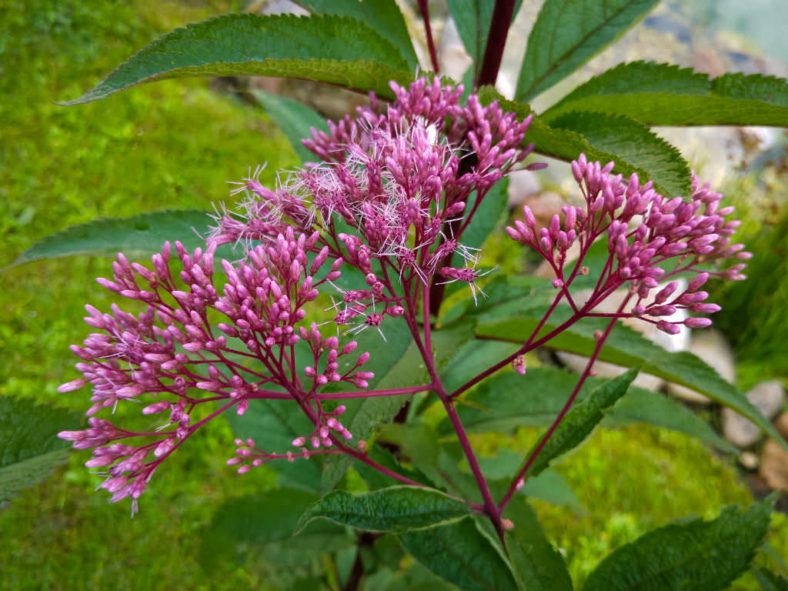Sweet Joe Pye Weed (Eutrochium purpureum), also known as Gravel Root, is a large clumping perennial that injects architectural interest into the late summer landscape. This robust wildflower has multiple sturdy stems with whorls of attractive foliage. In mid-summer, plants are topped with a frothy crown of rounded rosy pink flower clusters. Butterflies frequent the vanilla-scented blooms.
It is native to northwest, eastern and central North America. Many people think of Sweet Joe Pye Weed is a weed found in the ditches along the side of the road. But it is a stunning perennial in the back of a border or cottage garden, particularly in meadows or native plant gardens. It just needs space to grow as the stand can reach heights of up to 10 feet (3 m) and widths of up to 5 feet (1.5 m). It also works great in rain gardens or even at the edge of ponds or streams.
In the Language of Flowers, Sweet Joe Pye Weed is said to mean Delay. It is sometimes cultivated and has escaped from cultivation in parts of New Zealand.
Growing Conditions and General Care
Sweet Joe Pye Weed is happiest with full sun to part shade in moist to wet soil. It prefers that the soil does not dry out, which is why clay works well for Joe Pye. It has no serious insect or disease problems.

Sweet Joe Pye Weed just isn't a fussy or difficult plant to grow. If you do not want Sweet Joe Pye Weed to spread hither and yon, then cut the seed heads off.
If you are propagating by seed in the fall, then plant thickly as germination is usually low. Propagation is best from softwood cuttings taken in late spring or by division in fall as they go dormant or in the spring just as shoots first appear.
Medicinal Uses
Sweet Joe Pye Weed has such a rich history of healing. This plant is said to get its name from Joe Pye, an Indian healer from New England during the time of the Pilgrims. He has used Eupatorium purpureum to treat various ailments, including deadly typhus outbreaks.
The entire plant is still used as alternative medicine. The roots are the strongest part of the plant for healing. If you crush the leaves, they have an apple scent. Once dried, they are burned to repel flies. Tea made from this plant is used as an alternative medicine for fever, urinary tract problems fever, rheumatism, gallstones, and fluid retention. The common name Gravel Root comes from the plant being used as a diuretic used to treat urinary infections and stones. The tops of the plant were steeped and then inhaled to treat colds. Fresh leaves were made into a poultice to treat burns.
The flower tops were even used as a good luck charm. Some Native American tribes still consider Joe Pye Weed to be an aphrodisiac.
Links
- Back to genus Eutrochium
- Plantpedia: Browse flowering plants by Scientific Name, Common Name, Genus, Family, USDA Hardiness Zone, or Origin

